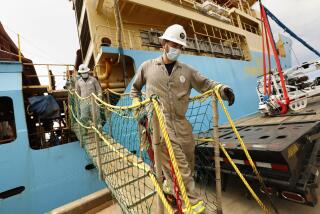Antarctic’s Harsh Environment Dims Prospects for Commercial Mining
- Share via
BUTTER POINT, Antarctica — Vast problems of weather and logistics could turn out to be better environmental protection for the Antarctic than the lobbying of conservationists or the diplomacy of the Antarctic Treaty.
A major New Zealand scientific drilling project through the pack ice covering the sea has shown that mining minerals is theoretically possible. But the teams who have broken new ground in drilling here say the problems, and the cost of solving them, are immense.
“We’ve proved that bedrock drilling here can be done,” Kevin Jenkins, the New Zealand program’s head driller, said. “But the problems are so enormous that every other place in the world has got to be easier than this.”
Despite one image of the Antarctic as an ice-covered treasure trove of oil and other minerals, scientists say no recoverable reserves of anything have yet been positively identified.
“We’ve got indications, and we’ve got some predictions based on the similarity of some geological features to other parts of the world, but no one’s got proof,” one geologist said.
Pioneering Effort
Butter Point, a tiny speck of a camp on the white sheet of the Bowers Piedmont Glacier running off the Antarctic continent onto ice-covered McMurdo Sound, is home base for the biggest, deepest drilling project ever successfully undertaken in the Antarctic.
Thirty minutes away, on six feet of sea ice that will melt away during the summer, sits a drill rig boring through the ice and into the seabed.
Almost completely enclosed against the ferocity of the Antarctic climate, the drill is worked around the clock in a race against time and the elements.
Operated by New Zealand scientists, the Cenzaoic Investigations in the Ross Sea (CIROS) project aims to find out more about the Antarctic millions of years ago, before it became a dead continent almost totally covered in ice.
Core samples taken from more than 2,000 feet beneath the current bed of McMurdo Sound have found traces of plant life, including a leaf apparently from a beech tree.
Results so far, however, have led scientists to conclude that the pre-glacial level is very much deeper and older than previously suspected.
Changes in the world’s climate and sea level have been attributed to the Antarctic’s ice sheet, and Peter Barrett, the New Zealand scientist heading the project, says that “we are trying to solve a worldwide problem.”
Major Effort
Core samples from the CIROS drill go back more than 40 million years and are being studied in Wellington and in the United States by the U.S. Geological Survey and Ohio State University.
The project is the flagship of the New Zealand Antarctic Research Program and has sucked up a major part of its resources.
“It’s becoming harder and harder for a small country like New Zealand, given its resources, to tackle problems that are of major international significance,” Barrett added.
A moratorium on mineral prospecting in the Antarctic has been agreed to by the 18 nations administering the continent under the Antarctic Treaty, and Barrett and Jenkins strenuously resist suggestions that the CIROS project is a concealed attempt to identify possible oil reserves.
They insist that care was taken in identifying the site to minimize the possibility of drilling in an area of potential gas or oil.
“If we were to hit anything like that it would completely ruin the project,” Jenkins said. “We would just fill the hole up with cement and walk away.”
While all those connected with the project are adamant that it has no hidden agenda of mineral exploration, they acknowledge that lessons learned on the CIROS project could be applied elsewhere.
‘Paving the Way’
“We’re aware of the value of being the only bedrock drilling project (in the Antarctic),” Barrett said.
“We’ve got the feeling of paving the way,” Jenkins added. “Nobody else has got the experience we’ve built up.”
The drillers have refined techniques to enable them to operate successfully here but have discovered that enormous problems are involved in any operation in the Antarctic.
“We’re 4,000 kilometers (2,500 miles) from civilization, we’re set up on two meters (six feet) of moving ice that will start to break up soon, we’ve got 200 meters (610 feet) of water to go through under the ice, which means the (drill) casing is just flopping about in midair, and that’s just the start,” Jenkins said.
Three years ago the wind demolished an drill rig. Last year effective temperatures went as low as minus 80 degrees centigrade. Heavy equipment, which cannot be moved onto the ice before it is thick enough to support the weight, must also be moved away and dismantled before the ice begins to weaken.
That leaves an operational drilling season of early October to late November. Equipment has to be shipped in almost a year before it will be used, and anything that breaks or is overlooked must be expensively replaced by air.
Platinum Mining Possible
“The logistics problems are crippling, and communications are a perpetual hassle,” Jenkins adds.
Despite the problems, Antarctic mining remains a possibility.
Dutch geologist Martin De Witt recently published a study suggesting that platinum mining could be feasible on exposed mountains standing above the constantly moving icecap of the polar plateau, although the presence of recoverable platinum has yet to be established.
Oil has been sucked from under the North Sea and from Alaska’s north shelf, part of which is inside the Arctic Circle. But in both places, conditions are less severe than the Antarctic.
“The reality of it is going to be price,” Barrett said.
More to Read
Sign up for Essential California
The most important California stories and recommendations in your inbox every morning.
You may occasionally receive promotional content from the Los Angeles Times.









